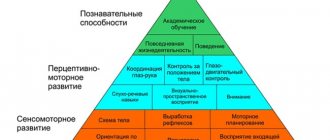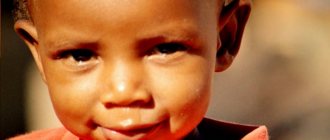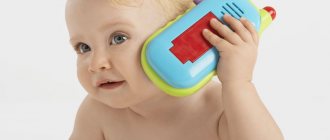The dynamics of children's development is monitored by a number of indicators, including growth. Moreover, the most rapid leap in development occurs during the first year of life. In just one month, children of this age can grow by 3-4 cm; the height of a 1-year-old child usually differs from a newborn by as much as 25 cm!
In the second year, babies grow a little slower, on average by 8-10 cm, and from 3 years old - by 4 cm per year.
Weight and height indicators for children: where did they come from and why are they needed?
As you know, during the first year of life, all infants will have a monthly visit to their local pediatrician. During these visits, doctors examine the little person, check whether there were any reactions to the vaccinations, and measure the baby’s height and weight. Thanks to the results obtained, the doctor can tell how the baby is developing, whether everything is fine, and whether there are any developmental abnormalities.
As you yourself understand, the rate of weight gain indicates whether the baby is eating enough, whether he has any disturbances in the functioning of the gastrointestinal tract or any other systems. Alternatively, if there is a discrepancy with the established standards in this matter, the doctor may recommend putting the baby to the breast more often, introducing supplementary feeding, or, conversely, feeding him less often and in smaller portions. Of course, it’s not very good if your child is constantly hungry, but it’s no better if your baby overeats all the time. Such children are more likely to suffer from colic and abdominal pain, and they may also be prone to obesity in adulthood.
So, let's summarize: weight and height, head and chest circumference are very important in pediatrics. Based on the primary figures that the doctor receives at birth and observing their changes during the first year of life, he can talk about the baby’s health status, its development, the presence of any pathologies, and also give recommendations regarding its diet, regimen, and other appointments.
Head circumference
What other figures characterize the development of children 1-2 years old? In addition to weight and height, regular head circumference measurements are also taken.
As with other parameters, this indicator differs slightly between boys and girls (see tables). Head circumference increases especially quickly in the first months of a baby’s life; in the second year the increase is about 2.5 cm.
Boys head circumference
Girls head circumference
In these tables, head circumference values are divided into groups. The blue column shows averages. “Green” also meets the standards, but is an acceptable deviation. The remaining head circumference values (“yellow” and “pink” column) may indicate the presence of pathology and require consultation with a neurologist.
Increased head circumference is more common than decreased head circumference. It is usually associated with vitamin D deficiency. But there are also more serious reasons.
In any case, you should not panic ahead of time and wait for terrible diagnoses. Perhaps this head size was “inherited” from relatives.
The ratio of height and weight parameters in children
Indeed, in medicine there are norms for the weight and height of children under one year old, which increase according to their age. However, we should not forget that each toddler is individual, and has its own individual heredity, quality of life, diet, sleep patterns, etc. Some experts argue that even the emotional background in the family can influence the increase in height and weight in a child.
An important role in assessing the developmental state of the baby is played by the relationship between height and weight, in other words, this index is called body mass index. Many mothers who try to watch their figure know about it first-hand. For a baby, the normal body mass index is equal to 13-21 points. It is he who gives us the opportunity to find out whether the baby is suffering from obesity or malnutrition, which requires medical intervention.
Average growth rates
The height of a healthy one-year-old baby should be between 74-80 cm. If the size of a toddler is below 71 cm, he is considered short or has problems. The upper limit of growth is 90 cm.
Monthly growth up to two years will average 1 cm. Typically, girls are somewhat behind boys in terms of figures.
Development is considered normal if deviations from the values in the table are within 3%; if the difference is more than 10%, you should seek help from a pediatrician.
At the same time, do not rush to sound the alarm if the child is genetically predisposed to other height and weight values. For example, when the baby’s parents themselves are not very tall or, at his age, also lagged behind their peers, the small size of the baby is quite acceptable. The main thing is that the centimeters “earned” by the toddler correspond to his body weight. This is easy to check using the table.
There is a special formula for calculating the height of children: add the height values of father and mother and divide the sum by 2. If you are raising a girl, subtract 2 cm from the resulting number. Parents of a son, on the contrary, need to add 5 cm.
Indicators of physical development of girls and boys up to one year
According to standards set by health authorities, girls have lower height and weight. Moreover, it is worth noting that if a child’s indicator reaches the lower mark, then this is a reason to consult a doctor.
Below I suggest that you familiarize yourself with the table, which shows the norms of height and weight for a child by month and until he reaches 1 year. It is worth noting that these data refer to children who were born on time, and no special difficulties or pathologies arose during delivery.
Table of norms for height and weight of children under 1 year
How to correctly calculate the norm?
In most cases, the pediatrician monitors the correct development of the child’s height and weight in the first year of life; for this, parents, starting from birth, bring the baby for examination monthly. At birth, the girth of the head is approximately 35 cm, and the chest is 32 cm. By 1 year, the girth of the head should exceed the volume of the chest by about 2 cm, no less.
Children who develop normally should have the following indicators, based on the parameters at birth: head circumference should increase by 11-12 cm over the year, chest circumference by 15-16 cm.
Non-critical deviations from the norm are not a sign of underdevelopment; it may be a hereditary factor.
Features of the first year of life
In terms of increasing the main indicators of physical development, the first year of a newborn is considered the most active. According to experts, during the first year of life, the “length” of a baby increases by 20-25 cm, and the weight doubles by 6 months and triples when it reaches one year.
If we analyze this issue in more detail, it is worth noting that in the first months of life, the baby gains the maximum number of kilograms, often this figure easily reaches 1-1.8 kg. In the future, when he becomes more active and mobile, the number of kilograms gained is significantly reduced. So, by 11-12 months the baby can gain 100-500 g, but at the same time, it is not considered a deviation if he does not gain anything.
As for growth, there are no clear trends, and everything depends on the conditions in which the child is located and his nutrition. The absolute norm would be if the baby grows by 5 cm in one month, and only by 1 cm in the next. However, to be sure that the baby is developing well, do not skip monthly visits to the pediatrician.
What does a baby's growth depend on?
The growth of children is carried out due to the production of a special hormone - somatotropin. This mainly happens when they are sleeping, namely between 22 and 24 hours. Another fact in favor of following the regime!
Thematic material:
- What toys does a 1 year old child need?
- What to give a 1 year old boy on his birthday
In addition to the above-mentioned hereditary prerequisites, the physiological development of the baby can be affected by the following:
- Mom's pregnancy. The fetus grows fastest from 3 to 6 months. At this time, the mother’s diet and her absence of bad habits are especially important.
- Nutrition. Breastfeeding is the best prevention against rickets. And also long walks and sunbathing!
- Place of residence. Nationality, natural conditions and ecology also affect the growth of a child. For example, the Dutch are considered quite tall - 170-185 cm (women and men), the Chinese, on the contrary, grow up to 155-165 cm.
Since the times of the Soviet past, Russians have “grown up” a little, the female half of the population is on average up to 165 cm, the male half is up to 175.
If the baby is sick, his growth may slow down a little, but he will definitely return to normal after recovery.
In some cases, growth canalization is observed. This happens when the reason that was holding back the baby's growth is eliminated. For example, premature and or low-weight babies by 12 months are catching up and even ahead of their peers.
Thematic material:
- What should a 1 year old child be able to do?
- How much should a 1 year old child weigh?
Table of weight and height indicators for a child (girls and boys) under 10 years of age
| Age, years | Boys | Girls | ||
| Weight, kg | Height, cm | Weight, kg | Height, cm | |
| 1 | 9,6 | 75,7 | 8,9 | 74 |
| 2 | 12,2 | 87,8 | 11,5 | 86,4 |
| 3 | 14,3 | 96,1 | 13,9 | 95,1 |
| 4 | 16,3 | 103,3 | 16,1 | 102,7 |
| 5 | 18,3 | 110 | 18,2 | 109,4 |
| 6 | 20,5 | 116 | 20,2 | 115,1 |
| 7 | 22,9 | 121,7 | 22,4 | 120,8 |
| 8 | 25,4 | 127,3 | 25 | 126,6 |
| 9 | 28,1 | 132,6 | 28,2 | 132,5 |
| 10 | 31,2 | 137,8 | 31,9 | 138,6 |
Diet of a child at 2 years and 8 months
Here is an example of a balanced menu for a week for a toddler aged 2 years 8 months with varied and tasty dishes
| Day | Breakfast | Dinner | Afternoon snack | Dinner |
| Monday | Semolina porridge, 20 g Tea with milk, 100 ml Sandwich with butter (30 grams of bread and 10 grams of butter) | Green salad with sour cream, 40 g Borscht with meat broth from early vegetables, 150 ml Beef zrazy with cottage cheese and onion, 60 g Buckwheat porridge, 100 g Apple juice, 100 ml Wheat, rye bread, 30/20g | Kefir, 150 ml Cookies, 15 g Fresh apple, 40 gr | Fish with vegetables in sour cream, 200 g Kefir, 150 ml Wheat and rye bread, 10 g each |
| Tuesday | Curd pudding with apples and nuts, 200 g Tea (not strong), 150 ml Sandwich with butter, 30/10 g | Apple and beet salad, 40 g Potato soup with semolina dumplings, 150 ml Mashed potatoes, 100 g Boiled meat stroganoff, 50 g Fruit compote, 100 ml Wheat, rye bread, 30/20 gr | Milk, 150 ml Oatmeal shortcake, 50 g | Omelette with cauliflower, 50 g Rice milk porridge, 150 g Kefir, 150 ml Wheat, rye bread, 10/10 gr |
| Wednesday | Vegetable salad from tomato with apple, 40 g Hercules milk porridge, 160 g Coffee with milk, 150 ml Sandwich with butter, 30/10 g | Herring snack, 40 g Hot beetroot soup, 150 ml Rice liver pie in milk gravy, 200 g Rose hip drink, 100 ml Wheat, rye bread, 30/20 gr | Milk jelly with black currants, 150 ml Curd shortbread, 50 g | Curd zrazy with pumpkin in fruit sauce, 200 g Kefir, 150 ml Wheat, rye bread, 10/10 gr |
| Thursday | Cheesecakes with apples and sour cream, 200 gr Boiled milk, 150 ml Sandwich with cheese, 30/10 g | Fresh cabbage salad with carrots and beets, 40 g Homemade rassolnik, 150 ml Steamed fish dumplings with sauce 60/40 g Mashed potatoes, 100 gr Tomato juice, 100 ml Wheat, rye bread, 30/20 gr | Kefir, 150 ml Cookies, 10 g Apple baked with sugar, 50 g | Potato balls with chopped egg and milk sauce, 200 g Kefir, 150 ml Wheat, rye bread, 10/10 gr |
| Friday | Rice milk porridge, 200 gr Cocoa with milk, 150 ml Sandwich with butter, 30/10 g | Green peas with butter and onion, 40 g Soup with corn grits and meatballs, 150 ml Beef balls with zucchini and cottage cheese, 50/100 g Strawberry jelly, 100 ml Wheat, rye bread, 30/20 gr | Nut milk, 150 ml Bun, 50 g | Cabbage cutlets with milk sauce, 120 g Cottage cheese with carrots, 80 g Kefir, 150 ml Wheat, rye bread, 10/10 gr |
| Saturday | Omelet with cottage cheese, 80 g Semolina cutlets with sour cream sauce, 120 g Coffee drink with milk, 150 ml Sandwich with butter, 30/10 g | Vegetable salad, 40 gr Milk soup with potato dumplings, 150 ml Rabbit cutlets, 60 g Buckwheat porridge, 100 g Dried fruit compote, 100 ml Wheat, rye bread, 30/20 gr | Kefir jelly, 50 g Apricot drink, 100 ml Cookies, 10 g | Cauliflower baked in sour cream, 150 g Marinated herring, 30 g Kefir, 150 ml Wheat, rye bread, 10/10 gr |
| Sunday | Beetroot with sour cream, 30 g Curd pudding with raisins and sour cream sauce, 150 g Coffee with milk, 150 ml Sandwich with butter, 30/10 g | Herring pate, 30 g Green borscht, 150 ml Stuffed beef cutlets, 60 g Semolina porridge with vegetable broth, 120 g Plum juice, 100 ml Wheat, rye bread, 30/20 gr | Kefir with crushed rowan and apples, 150 ml Oatmeal shortbread, 50 g | Rice cake with fish and milk sauce, 120 g Carrots stewed in sour cream, 80 g Kefir, 150 ml Wheat, rye bread, 10/10 gr |
It is not necessary to follow the recommendations given. It will be enough to follow a few rules when creating a menu for your baby.
- Every day there should be lean meat about 90 grams, offal once or twice a week.
- Fish 2-3 times a week, 70-100 grams per day.
- Minimum 600 ml of dairy products , of which 200 ml of kefir or fermented milk is required.
- Cottage cheese can be present in raw form or in puddings, casseroles, and cheesecakes several times a week.
- 3-4 times a week egg .
- 6 grams of vegetable and 12 grams of butter daily.
- Vegetables and fruits - at least 250 grams per day.
- Bread - about 100 grams per day.
Indicators for girls and boys from 11 to 17 years old
Below is a table that contains indicators of the normal weight and height of children. However, it is worth noting that the range for this age is quite wide, since this is the period of puberty. It is during this period that certain changes related to hormonal levels may occur in the child’s body.
For girls, extra pounds are especially painful, but following strict diets at this age is not recommended, since a lack of healthy and nutritious vitamins can lead to the development of serious diseases in the future.
| Age, years | Boys | Girls | ||
| Weight, kg | Height, cm | Weight, kg | Height, cm | |
| 11 | 31,0-39,9 | 138,5-148,3 | 30,7-42,5 | 138,2-152,4 |
| 12 | 34,4-45,1 | 143,6-154,5 | 36-45,4 | 146,3-160,1 |
| 13 | 38,0-50,6 | 149,8-160,6 | 43,0-52,5 | 151,8-159,8 |
| 14 | 42,8-56,6 | 156,2-167,7 | 48,2-58,0 | 155,4-163,6 |
| 15 | 48,3-62,8 | 162,5-173,5 | 50,6-60,5 | 157,2-166,0 |
| 16 | 54,0-69,6 | 166,8-177,8 | 51,8-61,3 | 158,0-166,8 |
| 17 | 59,8-74,0 | 171,6-181,6 | 49,2-68 | 158,6-169,2 |
Possible problems
Improving the psycho-emotional development of a child at 1.5 years old does not pass without leaving a trace. Behavior problems appear, children become uncontrollable, and at any action they don’t like, they scream and throw a tantrum. Many people begin to bite during this period.
Such breakdowns most often occur against a background of fatigue or nervous tension. A small vocabulary does not allow the child to express negativity, so he resorts to such expression of emotions. Until two years, such whims mean nothing, and after that they turn into manipulation and become a way to achieve their goals.
Therefore, you should not endure all sorts of explosions and let the development of events take their course. It is better to switch the child’s attention to another subject, distract him, but not follow the lead, fulfilling the demands of a whim.
There is no need to be upset if the development of a 1.5-year-old baby lags behind the standards. The main indicator of physical and emotional health at this age is not height and weight, but stable dynamics of forward movement. You need to read, play, study, talk with your child - and the result will not be long in coming.
Photo: ru.freepik.com
List of sources:
- Pediatrician's Handbook" edited by V.O. Bykova //Stavropol, 2004
- Vasilyeva E.I. Physical development of children: educational and methodological manual for foreign students // GBOU VPO IGMU of the Ministry of Health of Russia. Irkutsk: IGMU, 2013 – 32 p.
- Aseev V. G. Developmental psychology: Textbook // Irkutsk, 1989.
- V.G. Maydannik, V.G. Burlay. Your child (Care and education) // Kyiv 2004. -298 p.
- Zemtsova, O.N. Literacy. Intellectual development of children 1-2 years old // M.: Makhaon, 2021. - 240 p.
- Veraksa, N. E. Child psychology. Textbook / N.E. Veraksa, A.N. Veraksa //M.: Yurayt, 2014. - 446 p.
Author
Elena Medvedeva
Specialist
Graduated from the Ural State Medical Academy of Yekaterinburg with a degree in General Medicine. Work experience: intensive care team, physician at an enterprise.
Share
Features of physical development during puberty
During this period there is a strong leap in the physical development of children. However, remember that everything basically depends on the individual characteristics of the child.
The figure of most children during puberty takes on a slightly disproportionate, awkward appearance. The fact is that at this age tubular bones begin to grow especially quickly, but the development of muscle mass slows down. Thus, you can see that the increase in height in one year was significant, but this was due to the elongation of the limbs, while the chest and pelvis remained the same size or increased slightly. This is why a teenager’s figure can take on such an awkward appearance.
In addition, such awkwardness leaves its mark on his behavior. So, for example, he becomes more clumsy, it is sometimes difficult for him to coordinate his movements, he can even occasionally walk down the street and wave his arms and not notice that he is disturbing people. This age is also characterized by increased emotionality and, accordingly, increased gesticulation when communicating. In this way, teenagers make up for the lack of expressiveness of speech. Removing this deficiency is quite simple; to do this, you will need to include training and exercises in your life.
As for the norms, on average, the growth rate increases by 4.3-6.7 cm per year, and for girls by 2.9-5.8 cm. The largest jump in this indicator can be noted at 13 years of age in girls and at 15 for boys. It is during this period that the growth rate in children over 2 years can increase by 20 cm.
Of course, as you grow, your weight also increases. This figure can also increase in leaps and bounds. Over the course of a year, it can increase by 2.4-5.3 kg in boys and by 2.5-5.2 in girls. At the age of 12, increased muscle mass begins to gain. It is worth noting that the structure of the muscles changes little, but the width of the fiber itself increases significantly. The muscles of teenagers become much stronger, this trend is especially observed in boys.
At this age, complex movements are easily remembered and learned. Thus, you can easily send your child to a sports or dance section, and rest assured that he will quickly be able to succeed there. Otherwise, a certain clumsiness and angularity of movements, which is inherent in children of this age, may remain for the rest of their lives.
Physical activity
Children aged one and a half years need active physical activity. They enjoy crawling, squatting, dancing, running and falling. This opportunity should be provided without restricting movements by the playpen. This will help develop coordination, improve attention and concentration, and teach you to avoid dangers.
What can an 18 month old baby do?
The development of a child’s motor skills proceeds quickly - by the age of one and a half years he should be able to easily perform the following movements:
- wave a flag;
- hold a ball or gymnastic stick in your hands;
- jump on the spot;
- change the position of the body in space;
- hide the cube behind your back;
- transfer the toy from hand to hand.
Most children at one and a half years old, with the help of an adult, can climb a low hill, roll a ball down it, step over obstacles on the floor, and go up and down a step.
How to develop
For the development of motor activity of a child at 1 year 5 months, the following activities are suitable:
- games that imitate the gait of animals;
- dancing;
- movement in a circle - playing train;
- clapping hands;
- squats;
- hide and seek;
- games of catch;
- throwing a ball at a target.
As the movements are mastered, balance, coordination and attention develop, the games become more complex and the location and situation or characters change.
Factors that influence growth rate and weight gain in children
In fact, physical development indicators are influenced by a huge number of factors, let’s look at which ones. So:
- Heredity. As you yourself understand, small and thin parents cannot grow up to be 2 meters strong. Of course, there are cases when the genes of grandparents play a role in the development of a little person, but in most cases, this is an exception to the rule than the rule itself.
- Diet. From the moment the first complementary foods are introduced, your baby’s diet should become varied. The daily menu must include dishes from meat and fish, dairy and fermented milk products, fresh vegetables and fruits. A lack of vitamins can lead to the fact that the baby will not gain weight well, and his height will not increase in any way. In addition to these problems, the development of more serious diseases is possible in the future, for example, anemia in a child or vitamin deficiency. All this, as you understand, plays an important role in the formation of immunity, so a lack of vitamins can lead to more frequent colds and viral diseases. If you see that your baby lacks any vitamins, because he is constantly tired, his visual acuity decreases, or his nails and hair are brittle, include vitamin complexes in his daily diet. Surely your local pediatrician will be able to offer several options.
- Frequent walks and sports clubs. Scientists have proven that frequent walks in the fresh air have a positive effect on the physical development of the baby. However, if your baby is hyperactive and you see that he would still run and run, then select a section with him that is interesting for him. Under the age of 5, you can choose anything: wrestling, tennis, basketball, swimming, football, but if you want to correct certain indicators of the baby’s development, then approach this issue more carefully. So, in order for the baby to stretch upward, choose sports such as volleyball, basketball, tennis, badminton.
- Family climate. Scientists have long proven that unloved children grow many times slower. No one talks about gifts and the number of toys; there can be a huge number of them, but the baby will not feel loved.
- Rest or sleep. Previously, our mothers and grandmothers frightened us with all sorts of horror stories, for example: “If you don’t eat porridge and don’t sleep, you’ll never grow up.” Jokes aside, but it's really true. The main hormone that is responsible for growth is produced in greater quantities at night. It is very important that the child has a routine; he knows when it is time for sleep and when it is time for rest. The best time to fall asleep is considered to be from 20:00 to 21:00. In addition, keep an eye on your baby’s daily routine; sleep at night should take about 10-11 hours, and he will sleep the remaining 2-3 hours during the daytime. Otherwise, it will be difficult for you to establish a routine for him.
- Other factors include: the presence of pathologies during pregnancy and delivery, the presence of genetic pathologies, infectious diseases in the child.
Lifestyle
Lifestyle is of great importance in the normal development of a child. It is from an early age that the habit of a daily routine, proper nutrition and active pastime is laid, which will bring enormous benefits in the future.
Mode
The baby needs to be picked up and put down at the same time; feeding and walking hours should not be delayed by more than 30 minutes. A strict regime teaches discipline, strengthens the nervous system and improves intellectual development.
Approximate child routine:
| Time | Mode |
| 8:00 — 8:30 | Wake up, wash, exercise |
| 8:30 – 9:00 | Breakfast |
| 9:00 – 9:30 | Developmental activities |
| 9:30 – 11:30 | Walk |
| 11:30 – 11:40 | Snack |
| 11:40 – 13:00 | Daytime nap |
| 13:00 – 14:00 | Gymnastics, outdoor games |
| 14:00 – 14:30 | Dinner |
| 14:30 – 16:00 | Walk |
| 16:00 – 17:30 | Daytime nap |
| 17:40 – 18:00 | Afternoon snack |
| 18:00 – 19:30 | Games, reading, walk |
| 19:30 – 20:00 | Dinner |
| 20:00 – 20:30 | Quiet games, reading |
| 20:30 – 21:00 | Getting ready for bed, bathing, washing |
| 21:00 | Dream |
Nutrition
By the age of one and a half years, a child should be able to use a spoon and a mug, sit at the table and calmly eat “adult” food. Homemade food can be combined with canned food. If the baby is breastfed, the diet is adjusted in accordance with the amount of milk from the mother. Artificial children at this age, as a rule, already do without formula.
Meals should be five times a day - 3 main meals and two snacks (after breakfast and after lunch). The interval between feedings is approximately the same. The daily volume of food is 1.1–1.3 kg, a single serving does not exceed 200–250 ml.
Sample menu for the day:
| Eating | Dishes |
| Breakfast | Oatmeal with milk, cocoa, cookies |
| 1 snack | Cottage cheese / cheesecakes / yogurt |
| Dinner | Meatball soup, stewed vegetables / cabbage-carrot salad, compote |
| 2 snack | Bread, kefir |
| Dinner | Mashed potatoes, fish cutlet, weak tea |
Food at this age becomes more and more varied. If a child is overweight at 18 months, the amount of carbohydrates in the diet is reduced and protein foods are added.
The basis of the children's menu is milk and dairy products, meat, fish, cereals, vegetables and fruits. It is strictly forbidden to give an 18-month-old baby “quick” food and semi-finished products: chips, sausages, frankfurters, french fries, store-bought juices, yoghurts and curds, sweet water. It is better to exclude sugar and everything that contains it from your diet.
Active children should not be restricted in fluids. Thirst can be quenched with clean water, tea, fruit drink, compote or herbal decoction. Freshly squeezed juices contain a lot of simple sugars, so you shouldn’t give them.
Dream
Children at this age sleep 14 hours a day. At the same time, 10–11 hours are spent on night rest, the rest is for daytime sleep. Most babies still sleep twice a day, but one nap is acceptable.
Care
You need to brush your baby’s hair every day, cut his nails once a week, clean his ears, and remove crusts from his nose.
Some children's skin becomes irritated by hard water and poor drying. To avoid this, it is recommended to use baby cream at night.
At one and a half years old, it’s time to teach your child to brush his teeth: give him a bright brush, show him the basic movements. All this is still in a playful form, but over time the baby will get used to the idea of the need for daily hygiene and will do it himself.
Useful video on how to teach a child to brush their teeth
After each bowel movement, girls and boys should be washed with warm water from front to back. Change bed linen once a week, and change your underwear when soiled.
Bathing
Daily baths are no longer necessary; you can get by with a shower. The time of adoption should be selected individually. Detergents - for children. You don't have to use them every day, clean water is enough.
Wash the baby with a personal sponge or just with your hand, especially carefully clean the groin folds and armpits. Bathing duration is 8–10 minutes.
Walks
For the physical development of a 1.5 year old child, it is necessary to go outside twice a day. In summer, it is recommended to organize a nap during the day. If time permits, you can spend 3–6 hours outdoors. You should not go for a walk in strong wind or rain.
Massage and gymnastics
Children at this age are characterized by increased fatigue, but quickly regain strength. Therefore, class time is divided by frequent breaks, the total duration of gymnastics is 20–30 minutes.
Active exercises should be alternated with passive ones, ending with a massage. Another option: give physical activity in the morning, and do massage in the evening.
Useful video with morning exercises for an 18-month-old child
Games
The favorite games of a 1.5-year-old child are catch-up and hide-and-seek. Children dance with pleasure, play with baby dolls and children's dishes, assemble construction sets, roll a car with a string, and try to imitate the sound of a horn and the noise of a motor.
All children at 18 months love to draw, hide toys, and look at pictures. With the development of intellectual abilities, a desire arises to find out what is inside an object. If you can’t spin the toy with your hands, the child throws it on the floor.
Useful video with games for 1.5 year old children
Deviations from the norm
All standards established by the Ministry of Health are only average indicators. Accordingly, if you see that your child is cheerful, active, eats well and plays, but is 1.5 kg less than the stated norm, then there is no reason to worry. However, if you notice that the increase in height over the year is less than 4 cm and less than 3 kg in weight, then this is a reason to consult a pediatrician.
The pediatrician will be able to examine the baby and suggest which specialist can help you in resolving this issue: a gastroenterologist, geneticist, neurologist or endocrinologist. Depending on the results of the examination, your baby may be prescribed a course of additional vitamins, changes in diet and lifestyle. In more serious cases, a course of treatment may be prescribed, which includes taking hormonal medications.
Video
I suggest you watch a very interesting short video in which a pediatrician talks about the characteristics of height and weight in children of different age groups.
When a baby is born, every mother faces certain problems. For example, with colic in a newborn, in addition, during the first year of life, the mother at least once faces the problem of a runny nose in the baby, which often becomes a symptom of teething, etc. However, unfortunately, few of us At the first symptoms that worry parents and the baby, seek advice from a pediatrician. For some reason, many of us are accustomed to listening to the opinions of grandmothers and strangers on this issue.
Often on the street you can meet people who express their opinions regarding the development indicators of your baby. However, so that you are in no way confused by the opinion expressed, today we looked at what standards of child development are present in modern medicine, and what to do in case of deviations. Now share with us in the comments on the site what trends in height and weight changes were observed in your baby, have you ever heard that he is too small or too big?
Speech of a child at two years and eight months
The baby is expanding his vocabulary every day. He speaks more and more clearly, although he still shortens or simplifies some complex words.
It is advisable for parents to be patient, because the “Why Chek” age begins , when the baby constantly asks something, often about the same thing several times, until he has learned the necessary information.
To develop speech, read more books with your baby. While reading, ask your child questions to determine if he is following the story.
Your baby can already take part in a conversation using simple sentences of 3-5 words. At his childish level, he understands what is being said and can insert his own words and phrases into the conversation.
Moreover, he can communicate not only with his loved ones, but also with random people in a store, on the street, in a clinic.









